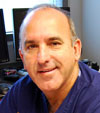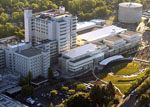New era dawns in emergency and trauma care at UC Davis Medical Center with opening of new state-of-the-art emergency department
Posted Oct. 6, 2010
A new era in emergency and trauma care dawns at UC Davis Medical Center on Wednesday, Oct. 6, when the expanded, state-of-the-art emergency department opens to the public for both walk-in patient and ambulance traffic.
The Emergency Department at UC Davis Medical Center is now
located on 45th Street, just north of X Street in Sacramento.
The emergency department is relocating after decades at its former location on V Street. One of the largest and busiest emergency departments in Northern California, and the largest in the Sacramento region, UC Davis serves a 33-county area and beyond. At more than 40,000 square feet, the new facility is more than double the size of the old, approximately 19,000-square-foot emergency department. The department has nearly two-thirds more patient beds, 68 versus 42 in the former emergency department.
The $32 million facility houses the only level 1 pediatric and adult trauma center in all of Northern California. There are only three level 1 pediatric and adult trauma centers in California. The other two — Loma Linda University Medical Center and Ronald Reagan UCLA Medical Center — are located in Southern California.
“This highly sophisticated facility enables UC Davis to respond to the growing, critical health needs of the people of Northern California,” said Ann Madden Rice, chief executive officer, UC Davis Medical Center. “As the only level 1 adult and pediatric trauma center in Northern California, UC Davis Medical Center has long focused on treating patients with the most complex and urgent illnesses and injuries — but we have been limited by our facilities. The opening of the emergency department marks a new era in meeting our community’s urgent trauma and emergency needs.”
Named the Michael W. Chapman Emergency and Trauma Center, the new facility’s state-of-the-art equipment and larger patient-care areas dramatically improve accessibility and treatment for the more than 55,000 patients who each year are admitted to the emergency department. It also improves the efficiency of admission and patient flow at UC Davis Medical Center.
 “This highly sophisticated facility enables UC Davis to respond to the growing, critical health needs of the people of Northern California.”
“This highly sophisticated facility enables UC Davis to respond to the growing, critical health needs of the people of Northern California.”
— Ann Madden Rice
In the past fiscal year, more than 53 percent of all patients hospitalized at UC Davis Medical Center were admitted to the hospital through the emergency department. On average, each month about 250 patients are admitted to intensive care units from the emergency department — a reflection of the very high level of acuity of medical center patients.
“The opening of the new emergency department is a transformational step for UC Davis Medical Center and for the patients we serve,” said Nathan Kuppermann, chair of the Department of Emergency Medicine in the UC Davis School of Medicine and medical director of the emergency department. "We’ve had slow, steady growth in our patient volume over the years. Unfortunately, we have had patients who we weren’t able see because we ran out of real estate. We will immediately be able to see more patients more quickly and efficiently in the new facility.”
Opening of the new emergency department is being coordinated with city and county agencies, including police, fire and emergency medical services agencies throughout Northern California. The department’s entrance, for more than 27 years off V Street, now will be on 45th Street.
The recently completed Surgery and Emergency Services Pavilion provides the new face of UC Davis Medical Center. In addition to the emergency department, the pavilion includes treatment spaces for high-acuity patients, including new operating rooms and recovery areas for cardiovascular, neurological and burn surgery patients, among others.
Slideshow: hover over each photo and use arrows to view next slide.
Above: 5:30 a.m. hustle in the new emergency department

Last-minute supplies arrive in the new emergency department


Emergency Department Professor and Chair Nathan Kuppermann directs staff minutes before first patients transfer to the new emergency department


Nurse Lindsay Brodersen and other staff prep for transfer of patients from old emergency department


Emergency Department Nurse Manager Debra Trainor hugs charge nurse Marion Korin, who oversaw the Oct. 6 emergency department shutdown


Patient waits with daughter in old emergency department for move to new emergency department


The last pediatric patient in old emergency department gets ready for discharge


First patient arrives in the new emergency department by ambulance


Emergency Department Professor and Chair Nathan Kuppermann announces opening of the new emergency department to the media


7 a.m. unveiling of new emergency department entrance, at last


"We have had an exceptional trauma service for decades, but now the quality of our facilities will reflect the excellent patient care that UC Davis physicians, nurses and staff deliver," said David Wisner, chair of the Department of Surgery at UC Davis. "This will be a significant improvement in the quality of the experience for the seriously injured patients for whom we care."
Sixty to 70 percent of the trauma patients admitted to the medical center require some type of surgery, most frequently orthopaedic surgery, general surgery, neurosurgery, plastic surgery and ophthalmologic surgery, among others. The new facility co-locates essential surgery, imaging, pathology and emergency department services to facilitate diagnosis and treatment. For example, the placement of the trauma center enables patients to be transferred to the operating room 75 percent faster.
The new emergency department has four patient-care areas, or “pods,” three for adult patients and a separate pediatric pod. In addition, it also will have an observation area for sick patients who may not need to be hospitalized, as well as a fast-track “up-front” area for less severely ill patients. These latter patients may only need a quick swab of the throat or prescription refill, and will receive care in a location where it can be delivered promptly.
Creation of these discrete treatment areas will help alleviate congestion and result in more efficient patient care and throughput. In some cases, patients who previously might have required overnight hospitalization may receive complete care in the emergency department.
“Some patients historically might have been admitted to the hospital for 24 hours and then been sent home,” Kuppermann said. “In the new emergency department we might admit a patient experiencing an asthma attack to a clinical decision area for observation and treatment. If their condition improves within 24 hours, they could be sent home without having to be admitted.”
 “The opening of the new emergency department is a transformational step for UC Davis Medical Center and for the patients we serve.”
“The opening of the new emergency department is a transformational step for UC Davis Medical Center and for the patients we serve.”
— Nathan Kuppermann
While the former emergency department had a separate pediatric treatment area, the new area for patients younger than 18 is larger, with 11 instead of seven beds. A new and much-welcome feature is a separate waiting room for children and their families, secluded from the waiting and patient-care area for adults.
“When we planned our new emergency department, we carefully considered how to best deliver outstanding quality of care to children and their families in the most comfortable, caring and safe environment,” Kuppermann said. “I think we have achieved that with our new pediatric emergency care area.”
Physicians treating children in the pediatric emergency department are the only ones in the Sacramento region specially trained in pediatric emergency medicine, with expertise in treating childhood emergencies. Equipment used in the pediatric department is specially designed and appropriately sized for children.
The new emergency department also has undergone a technological transformation to improve patient care by increasing efficiency. For example, rather than registering patients at a desk before admitting them to the emergency department, the new facility will enable bedside registration using an electronic system.
Learn more about UC Davis Medical Center
 UC Davis Medical Center is a comprehensive academic medical center where clinical practice, teaching and research converge to advance human health. Centers of excellence include the National Cancer Institute-designated UC Davis Cancer Center; the region's only level 1 pediatric and adult trauma centers; the UC Davis MIND Institute, devoted to finding treatments and cures for neurodevelopmental disorders; and the UC Davis Children's Hospital.
UC Davis Medical Center is a comprehensive academic medical center where clinical practice, teaching and research converge to advance human health. Centers of excellence include the National Cancer Institute-designated UC Davis Cancer Center; the region's only level 1 pediatric and adult trauma centers; the UC Davis MIND Institute, devoted to finding treatments and cures for neurodevelopmental disorders; and the UC Davis Children's Hospital.
The medical center serves a 33-county, 65,000-square-mile area that stretches north to the Oregon border and east to Nevada. It further extends its reach through the award-winning telemedicine program, which gives remote, medically underserved communities throughout California unprecedented access to specialty and subspecialty care. For more information, visit www.ucdmc.ucdavis.edu/medicalcenter.
“When we see patients, we’ll be doing documentation right at the bedside,” Kuppermann said. “We’re essentially a paperless emergency department.”
The emergency department has more than 29 full-time physicians who are board-certified in emergency medicine, including nationally and internationally known experts in emergency care and research. They include researchers and specialists in the effects of gun violence, toxicology, ultrasonography, medical simulation, airway and respiratory emergencies, head and abdominal trauma, and the appropriate use of CT scans in pediatric patients. The emergency department physician staff also includes 40 residents, three fellows and eight clinical faculty members. There are 135 nurses who work in the emergency department, including administrative staff and nurse practitioners.
The emergency department is a State of California designated poison center. Other areas of expertise/services include:
- Acute Chest Pain Intervention Service
- National Pediatric Emergency Medicine Research Center
- Trauma — Emergency Care Collaboration Group
- Wilderness Medicine
- Emergency Medical Services — Injury Prevention Section
- Ultrasound Research Center
- Injury Research Program
The trauma center and emergency department are named for internationally known orthopaedic surgeon Michael Chapman. The Michael W. Chapman Emergency and Trauma Center honors Chapman, who is considered one of the fathers of modern trauma surgery and served two decades as chair of the UC Davis Department of Orthopaedic Surgery. Adjacent to the trauma center, the Elizabeth C. Chapman Emergency Department Waiting Room recognizes Chapman’s wife, Elizabeth. Within the trauma center, a treatment area devoted exclusively to pediatrics is named Lions Education Foundation District 4-C5 and Lions Clubs International Foundation Pediatric Emergency Room.
